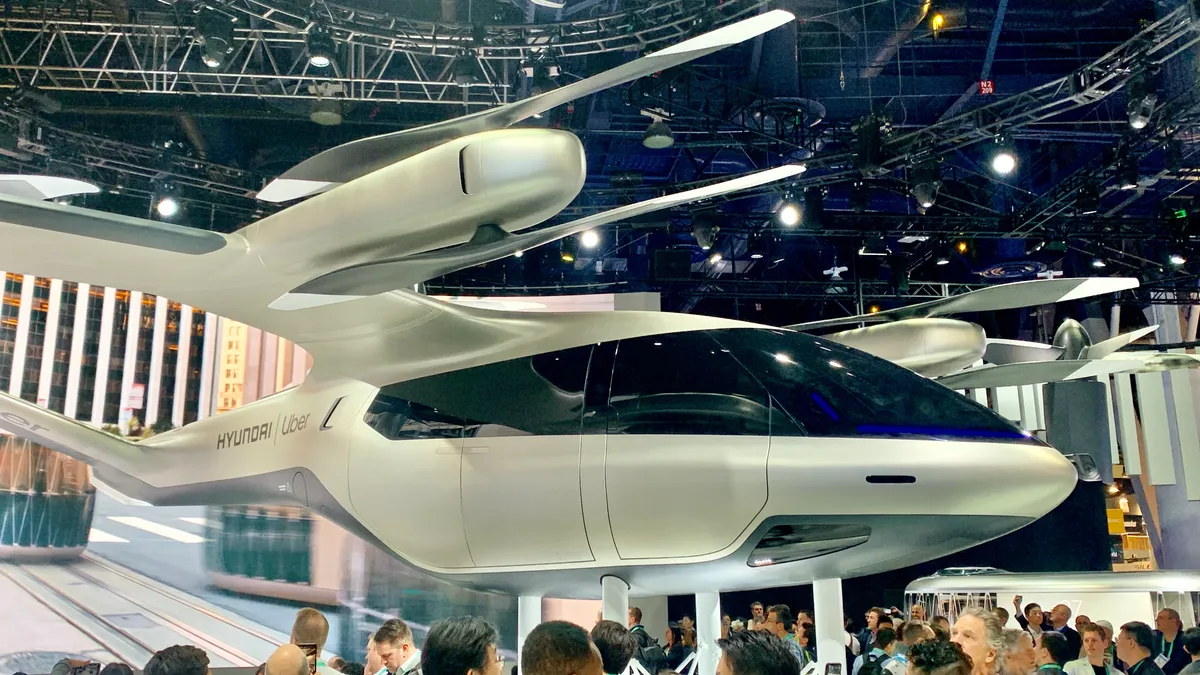Dive Brief:
- The advanced air mobility (AAM) sector could be worth $115 billion by 2035, according to a new report, but a national strategy around regulations and public-private partnerships (P3s) is necessary to ensure success.
- The AAM industry, which includes electric vertical takeoff and landing (eVTOL) aircraft that can be used to move people and goods, could create 280,000 jobs in the commercial aircraft sector, according to new research from Deloitte and the Aerospace Industries Association (AIA). But the report warns that while the United States could be a world leader in deploying the technology, China, South Korea and Germany are also competing hard, and the U.S. must stay ahead.
- For the U.S. to remain competitive, the report calls for a comprehensive national strategy that creates a "clean and conducive policy environment" to ensure safety while certifying aircraft for use; ensure continued research, development and manufacturing in the necessary technology for AAM like batteries, artificial intelligence (AI) and 5G; and scale the market by building physical infrastructure, drives demand and positions the industry to export its goods globally.
Dive Insight:
AAM, eVTOLs and the like — often referred to under the catch-all term of "flying cars" — have been the subject of much hype in recent years. And representatives of the Federal Aviation Administration (FAA) have said plans for flying cars are more than just hype and are close to reality.
The Deloitte and AIA report, which is based on interviews with more than 50 aerospace and automotive leaders as well as a survey of 102 senior industry and policy executives in the United States, says public and private sector collaboration will be crucial if the country is to be a world leader on the growing technology.
Such partnerships will require a regulatory framework that emphasizes safety while also allowing aircraft to be quickly certified. Uber had planned an aerial ride-hailing service of its own before selling that arm of its business to Joby Aviation, and had previously said that no new laws would be required to get its aircraft off the ground, a sentiment this report echoed.
However, as more companies continue to add aircraft to the skies, and especially as the airspace becomes more crowded with delivery drones and the like, the report says regulation must keep pace to ensure that every airborne vehicle can coexist peacefully. Cities that are already ahead of the curve on planning for AAM like Los Angeles are a local example to follow, while federal support is available through the likes of NASA, according to the report. State-level action could come too, following New Hampshire’s legislation last year on so-called "roadable vehicles."
"As our air system becomes more robust, our governments are going to have to make sure that it keeps apace to allow the growth that is necessary for us," said David Silver, AIA's vice president of civil aviation. "It really comes down to from a regulation standpoint, it's really making sure we can certify and operate these aircraft today, then make sure we can integrate them in today's airspace as it exists today, make sure we standardize these processes, and then ultimately, continuously improve them such that we can continue to grow at scale."
Not only will the technology within the AAM aircraft themselves have to be scalable and constantly improved, but the surrounding infrastructure will need to be similarly prepared too, said Deloitte’s U.S. and Global Aerospace & Defense Leader Robin Lineberger. That will mean strengthening communications networks to enable safe air traffic control, and ensuring the manufacturing supply chain can keep up with demand for the aircraft, he said.
Cities can also help by preparing infrastructure for eVTOL and other AAM aircraft, including the skyports on top of parking garages that have been rendered in the past by Uber, Lineberger added. "We've got to be able to produce at near automotive rates," he said.
By collaborating and helping AAM offerings scale up, the report says the U.S. could be a world leader in the technology, especially if it exports that technology to other countries while leading on aircraft safety. That reputation took a hit with the Boeing 737 MAX, which was grounded in 2019 after several high-profile crashes. Lineberger said AAM could present a new opportunity for the U.S. to lead the world.
"Something we should lead with here is the same or greater level of safety which the United States has demonstrated over a century," he said. "We're the world leader in safety, and when — hopefully not if — when these policies go through, and the vehicle and the operations get set with a demonstrable safety record, the world will look to that."












